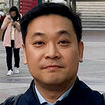NANO KOREA 2023
A special issue of Micromachines (ISSN 2072-666X).
Deadline for manuscript submissions: closed (1 September 2023) | Viewed by 1072
Special Issue Editors
Interests: atomic force microscopy; electrical/electrochemical nanobiosensors; optical nanobiosensors; biochips; BioMEMS and BioNEMS; nanobiomaterials for environments; nanotechnology for bio-robotics; nanotechnology for tissue engineering and regenerative medicine; nanomaterials and nanotechnology in drug and gene delivery; nano-toxicology; sample preparation; molecular diagnostic system; bioanalytical engineering
Special Issues, Collections and Topics in MDPI journals
2. Department of Nano-Mechatronics, Korea University of Science and Technology (UST), Daejeon 34113, Republic of Korea
Interests: quantum dots; semiconductors; metals; nanolithography; photolithography; nanoimprint; scanning probe lithography; 3D printing; atomic force microscopy; carbon nanotube; flexible device; stretchable device; nanometrology; ultrafast laser processing; laser scanning microscopy; nanomaterial-based flexible device; maskless digital lithography
Special Issues, Collections and Topics in MDPI journals
Interests: semiconductor logic device; memory device; power device; display device; optoelectronic device; electronic nanomaterials; semiconductors; 2D nanodevice; nanowire FET; neuromorphic computing memristive device; resistive-switching device; ferroelectric FET; flexible device; advanced semiconductor and display devices; materials; process technology
Special Issues, Collections and Topics in MDPI journals
Interests: nano sensors; nanoenergy; electronic skin with physical sensor; plasmonics; nanostructures; nanocomposites; piezoelectronics; energy harvesting; triboelectric; atomic force microscopy; tip-enhanced Raman spectroscopy; physical sensor; flexible device; stretchable device; nanomechanics; meta-materials
Special Issues, Collections and Topics in MDPI journals
Special Issue Information
Dear Colleagues,
The NANO KOREA Symposium, Korea’s largest symposium on nanoscale science and technology, is an opportunity to discuss major research results and up-to-date research trends in Korea and overseas. The NANO KOREA 2023 Symposium, which will be held from 5th to 7th of July 2023 in KINTEX, Korea, will consist of advanced programs on the main theme of “Nanodevice: Evolving into Intelligent Semiconductors”. This NANO KOREA Symposium 2023 Special Issue will contain research results and reviews on the most important and latest developments and future trends or visions for the convergence of various technologies from a nano to microscopic scale. The symposium programs will cover the following main topics:
- (TS01) Nano Energy Harvesting;
- (TS02) Nanotechnology for Carbon Neutrality;
- (TS03) Nanotechnology for Next-Generation Energy Storage;
- (TS04) Nanobiotechnology;
- (TS05) Nanomedicine;
- (TS06) Nanoelectronic Devices and Neuromorphic Devices;
- (TS07) Nanophotonics;
- (TS08) Hybrid Nanomaterials for Next-Generation Convergence Science and Technology;
- (TS09) Nanofabrication Platform;
- (TS10) Nano Metrology and Characterization;
- (TS11) Nano-EHS and Standardization of NT;
- (TS12) Materials Modeling and Data Science for NT;
- (TS13) Nanotechnologies for Next-Generation Sensors.
You may choose our Joint Special Issue in Nanomaterials.
You may choose our Joint Special Issue in Applied Sciences.
Prof. Dr. Junhong Min
Prof. Dr. Won Seok Chang
Prof. Dr. Changhwan Choi
Dr. Dukhyun Choi
Guest Editors
Manuscript Submission Information
Manuscripts should be submitted online at www.mdpi.com by registering and logging in to this website. Once you are registered, click here to go to the submission form. Manuscripts can be submitted until the deadline. All submissions that pass pre-check are peer-reviewed. Accepted papers will be published continuously in the journal (as soon as accepted) and will be listed together on the special issue website. Research articles, review articles as well as short communications are invited. For planned papers, a title and short abstract (about 100 words) can be sent to the Editorial Office for announcement on this website.
Submitted manuscripts should not have been published previously, nor be under consideration for publication elsewhere (except conference proceedings papers). All manuscripts are thoroughly refereed through a single-blind peer-review process. A guide for authors and other relevant information for submission of manuscripts is available on the Instructions for Authors page. Micromachines is an international peer-reviewed open access monthly journal published by MDPI.
Please visit the Instructions for Authors page before submitting a manuscript. The Article Processing Charge (APC) for publication in this open access journal is 2600 CHF (Swiss Francs). Submitted papers should be well formatted and use good English. Authors may use MDPI's English editing service prior to publication or during author revisions.







